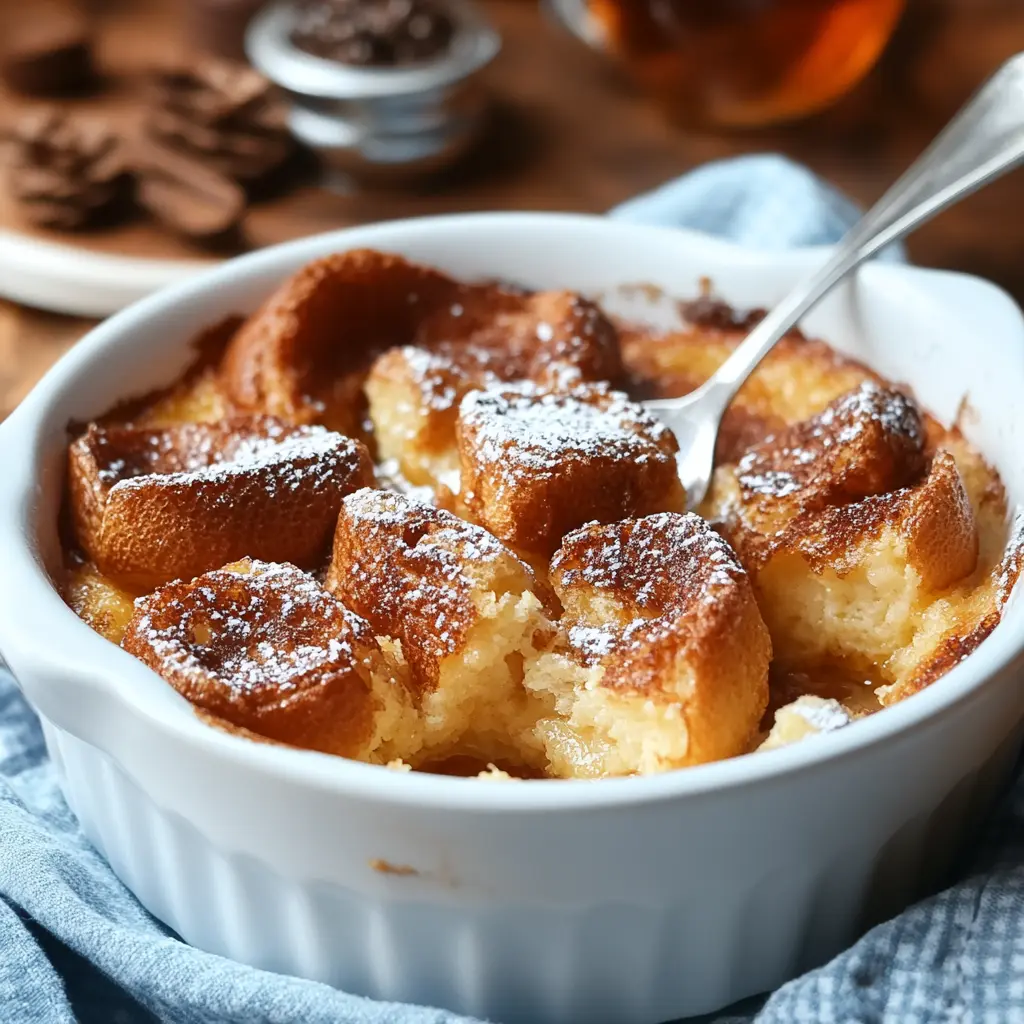Description: This French Toast Casserole is the ultimate make-ahead breakfast or brunch centerpiece. It transforms humble day-old bread into a rich, custardy delight, infused with warm spices and a hint of nutty goodness. Perfect for holidays, special occasions, or simply a weekend treat, this casserole requires minimal effort and yields maximum flavor.
Why You Will Love This Recipe:
- Make-Ahead Convenience: Prepare the entire casserole the night before and simply pop it in the oven in the morning for a stress-free breakfast.
- Crowd-Pleasing Flavor: The combination of sweet custard, warm spices, and buttery bread creates a symphony of flavors that will delight everyone at the table.
- Versatile Customization: Easily adapt the recipe to suit your preferences by adding different fruits, nuts, or spices.
- Minimal Effort, Maximum Impact: This casserole is surprisingly easy to make, yet it delivers impressive results that will impress your guests.
- Transforms Day-Old Bread: A fantastic way to use up leftover bread, turning it into a delicious and decadent breakfast.
Introduction
French toast, in its simplest form, is a timeless classic. But what if you could elevate this breakfast staple to a whole new level of convenience and indulgence? Enter the French Toast Casserole – a game-changer for anyone who loves a leisurely brunch without the morning hustle.
This recipe is more than just a collection of ingredients; it’s an invitation to savor the moments with loved ones, without being tethered to the stove. Imagine waking up to the aroma of warm cinnamon and vanilla, knowing that a delectable breakfast is just a bake away.
This French Toast Casserole recipe is designed for ease and flexibility. Whether you’re hosting a holiday brunch or simply craving a comforting weekend breakfast, this casserole is guaranteed to become a new family favorite. So gather your ingredients, prepare the dish the night before, and wake up to a breakfast that is both effortless and extraordinary.
Ingredients:
- 1 loaf of day-old French bread, cut into 1-inch cubes (about 12 cups)
- 8 large eggs
- 2 cups whole milk
- 1/2 cup heavy cream
- 1/2 cup granulated sugar
- 1/4 cup brown sugar, packed
- 2 teaspoons pure vanilla extract
- 1 teaspoon ground cinnamon
- 1/4 teaspoon ground nutmeg
- Pinch of salt
- 1/2 cup pecans, chopped (optional, but highly recommended)
- 1/4 cup butter, melted, plus more for greasing the pan
- Maple syrup, for serving (the real stuff is best!)
Preparation:
Step 1: Prepare the Dish
Begin by generously greasing a 9×13-inch baking dish with butter. This ensures that the casserole doesn’t stick to the bottom and allows for easy serving. Spread the bread cubes evenly across the bottom of the prepared dish. Make sure that the cubes are distributed in a single layer, maximizing their exposure to the custard.
Step 2: Mix the Custard
In a large mixing bowl, whisk together the eggs, whole milk, heavy cream, granulated sugar, brown sugar, vanilla extract, ground cinnamon, ground nutmeg, and salt. Whisk until all the ingredients are fully combined and the mixture is smooth and slightly frothy. This ensures that each ingredient is evenly dispersed, contributing to a balanced and flavorful custard. The brown sugar adds depth and a touch of caramel-like sweetness, complementing the warm spices.
Step 3: Soak the Bread
Slowly pour the custard mixture evenly over the bread cubes in the baking dish. Gently press down on the bread cubes with a spatula or your hands to ensure that they are fully submerged in the custard. This step is crucial, as it allows the bread to absorb the liquid and transform into a soft, custardy base. Cover the baking dish tightly with plastic wrap or aluminum foil and refrigerate for at least 4 hours, or preferably overnight. This soaking period allows the bread to fully absorb the custard, resulting in a richer, more flavorful casserole. The longer it soaks, the better the texture will be.
Step 4: Preheat & Assemble
When you’re ready to bake, preheat your oven to 350°F (175°C). While the oven is preheating, remove the casserole from the refrigerator and let it sit at room temperature for about 20-30 minutes. This helps to ensure even baking. Sprinkle the chopped pecans evenly over the top of the casserole. Drizzle the melted butter evenly over the pecans. The nuts add a delightful crunch and nutty flavor, while the melted butter creates a golden-brown, slightly crispy topping.
Step 5: Bake
Place the baking dish in the preheated oven and bake for 45-55 minutes, or until the top is golden brown and the center is set. To check for doneness, insert a knife or toothpick into the center of the casserole. If it comes out clean or with just a few moist crumbs, it’s ready. If the top starts to brown too quickly, you can loosely cover the casserole with aluminum foil for the last 15-20 minutes of baking.
Step 6: Serve
Once baked, remove the casserole from the oven and let it cool slightly for about 10-15 minutes before serving. This allows the custard to set further and makes it easier to cut and serve. Drizzle generously with maple syrup and serve warm.
COOKING Rating:
- Ease of Preparation: Easy
- Flavor Complexity: Medium
- Overall Rating: 5/5 Stars
Serving Suggestions:
- Drizzle generously with warm maple syrup.
- Serve with a dollop of whipped cream or a scoop of vanilla ice cream.
- Add fresh berries, such as blueberries, raspberries, or strawberries.
- Dust with powdered sugar for an elegant presentation.
- Serve alongside crispy bacon or sausage for a complete breakfast.
Tips:
- For the best results, use day-old French bread. This will absorb the custard better and prevent the casserole from becoming soggy.
- Don’t overbake the casserole, as this can make it dry. It’s ready when the top is golden brown and the center is set.
- If you don’t have pecans, you can substitute with other nuts, such as walnuts or almonds.
- To add a hint of citrus flavor, add a teaspoon of orange zest to the custard mixture.
- For a boozy twist, add a tablespoon of bourbon or rum to the custard mixture.
- If you are short on time, you can soak the bread for as little as 2 hours, but the longer it soaks, the better the results.
- To prevent the top from browning too quickly, cover the casserole with foil during the last 15 minutes of baking.
- Leftovers can be stored in the refrigerator for up to 3 days. Reheat in the microwave or oven until warmed through.
Prep Time:
- 15 minutes
Cook Time:
- 45-55 minutes
Total Time:
- Approximately 1 hour, plus at least 4 hours (or overnight) for soaking.
Nutritional Information:
(Approximate values per serving, based on 8 servings):
- Calories: 450-550
- Protein: 15-20g
- Sodium: 200-300mg
Conclusion
The French Toast Casserole is a symphony of flavors and textures that come together to create a breakfast or brunch experience that is both comforting and decadent. Its make-ahead convenience, versatile nature, and crowd-pleasing appeal make it an ideal dish for any occasion. Whether you’re celebrating a special holiday or simply looking for a way to elevate your weekend breakfast routine, this recipe is sure to become a staple in your repertoire. So, gather your ingredients, prepare the dish, and get ready to savor the delightful flavors of this exceptional French Toast Casserole.
Questions and Answers About This Recipe:
Q1: Can I use a different type of bread?
A: Absolutely! While French bread is the traditional choice for French Toast Casserole, you can certainly experiment with other types of bread. Brioche bread is an excellent alternative, as it is rich and buttery, adding an extra layer of decadence to the casserole. Challah bread is another great option, as it has a slightly sweet flavor and a soft, pillowy texture. However, keep in mind that different types of bread will absorb the custard differently. For example, denser breads may require a longer soaking time, while softer breads may become too soggy if soaked for too long. Adjust the soaking time accordingly to achieve the perfect balance of moisture and texture.
Q2: What if I don’t have heavy cream? Can I substitute it with something else?
A: Yes, you can definitely substitute heavy cream in this recipe, although the results may vary slightly. Half-and-half is a good alternative, as it has a similar consistency to heavy cream but with a lower fat content. You can also use whole milk, but the casserole may not be as rich and creamy. Another option is to use a combination of milk and butter. For example, you could use 1 3/4 cups of whole milk and 1/4 cup of melted butter to replace the 1/2 cup of heavy cream. This will help to add some richness back into the custard. Ultimately, the best substitution will depend on your personal preferences and the ingredients that you have on hand.
Q3: Can I add fruit to this French Toast Casserole?
A: Absolutely! Adding fruit to French Toast Casserole is a fantastic way to enhance its flavor and nutritional value. Berries, such as blueberries, raspberries, and strawberries, are popular choices, as they add a burst of sweetness and a touch of acidity. Diced apples or pears are also delicious, especially when paired with cinnamon and nutmeg. You can add the fruit directly to the bread cubes before pouring the custard over them, or you can layer the fruit in between the bread cubes. If you’re using frozen fruit, be sure to thaw it and drain off any excess liquid before adding it to the casserole. This will prevent the casserole from becoming too soggy.
Q4: How do I prevent the casserole from becoming soggy?
A: Preventing sogginess is key to achieving the perfect French Toast Casserole. Here are a few tips to help you avoid this common pitfall:
- Use day-old bread: Day-old bread is drier and more porous than fresh bread, which allows it to absorb the custard without becoming overly soggy.
- Don’t over-soak the bread: While soaking the bread is essential for infusing it with flavor and moisture, over-soaking can lead to a soggy casserole. Follow the recommended soaking time in the recipe and adjust it accordingly based on the type of bread you’re using.
- Drain excess liquid: If you’re using frozen fruit or other ingredients that release liquid, be sure to drain off any excess liquid before adding them to the casserole.
- Don’t overbake the casserole: Overbaking can cause the custard to dry out and the bread to become tough and soggy. Bake the casserole until the top is golden brown and the center is set, but not overly firm.
Q5: Can I make this recipe vegan or gluten-free?
A: Yes, with a few modifications, you can adapt this French Toast Casserole recipe to be vegan or gluten-free. For a vegan version, substitute the eggs with a plant-based egg replacer, such as a flaxseed egg or a commercial egg replacement product. Use plant-based milk, such as almond milk or soy milk, in place of the dairy milk and heavy cream. You can also use a vegan butter alternative for greasing the pan and drizzling over the top of the casserole. For a gluten-free version, simply use gluten-free bread in place of the regular French bread. There are many excellent gluten-free bread options available, so choose one that you enjoy. Be sure to check that all of the other ingredients you’re using are also gluten-free.




